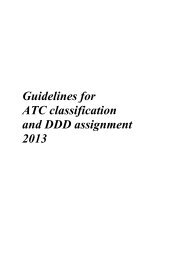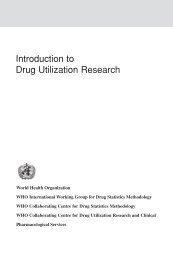Download - WHOCC
Download - WHOCC
Download - WHOCC
Create successful ePaper yourself
Turn your PDF publications into a flip-book with our unique Google optimized e-Paper software.
1.3 Relationship between the ATCvet system and the ATC system for medicines for human<br />
use<br />
The ATCvet system is based on and annually updated according to the changes in the ATC<br />
system for substances used in human medicine. Many of the substances may thus not have a well<br />
established use or may be of limited relevance for veterinary medicine. However,<br />
pharmacotherapy in veterinary medicine is rapidly developing, and substances and groups of<br />
drugs regarded to be of limited relevance some years ago, are now included in armamentarium of<br />
the veterinarians.<br />
The ATCvet system as it is outlined in the ATCvet Index and Guidelines for ATCvet<br />
classification should be regarded as a maximum selection to choose from when classifying<br />
products in veterinary medicine. Derived from the ATC system the ATCvet system is modified<br />
with some minor adaptations created to better fit the system to its purpose. In most cases an<br />
ATCvet code can be created by placing the letter Q in front of an existing ATC code in the<br />
human ATC system when classifying a product in the ATCvet system. In some cases, specific<br />
ATCvet codes are created. An additional 1 st level, QI - Immunologicals, is also included to<br />
accommodate vaccines and immunologicals according to species.<br />
1.4 The ATCvet classification systems<br />
In both the ATC and the ATCvet systems, preparations are divided into groups, according to<br />
their therapeutic use. First, they are divided into 15 anatomical groups (1st level), classified as<br />
QA-QV in the ATCvet system.<br />
Within most of the 1st level groups, preparations are subdivided into different therapeutic main<br />
groups (2nd level), coded for example as QA01, QA02, QA03. Two levels of<br />
chemical/therapeutic/pharmacological subgroups (3rd and 4th levels), e.g. QA02A, QA02B. at<br />
the 3rd level and QA02AA, QA02AB etc at the 4th level, provide further subdivisions. At a 5th<br />
level, e.g. QA02AA01, chemical substances are classified.<br />
Anatomical groups (1st level):<br />
ATCvet ATC<br />
1st level<br />
QA Alimentary tract and metabolism A<br />
QB Blood and blood forming organs B<br />
QC Cardiovascular system C<br />
QD Dermatologicals D<br />
QG Genito-urinary system and sex hormones G<br />
QH Systemic hormonal preparations, excl. sex hormones and insulins H<br />
QI Immunologicals -<br />
QJ Antiinfectives for systemic use J<br />
QL Antineoplastic and immunomodulating agents L<br />
QM Musculo-skeletal system M<br />
12





